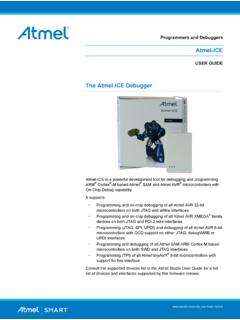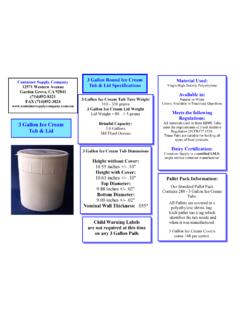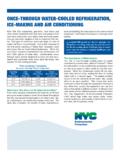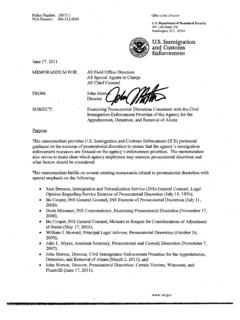Transcription of Manual Refrigerator Diagnostic Service Manual - …
1 DOMETICD ometicMANUAL REFRIGERATORDIAGNOSTIC SERVICEMANUALThe Dometic CorporationCorporate OfficeWarrantyDepartment2320 Industrial ParkwayElkhart, IN 46515219-295-5228205 E. Fenn , IN 46761219-463-2191 Technical ServicesDepartment509 S. Poplar , IN 46761219-463-4858OS1286 8/89D-lNOTES:D-2 Manual REFRIGERATORDIAGNOSTIC Service MANUALT able of ContentsPageDiagnostic Flow ChartsNo Operation ..No 12OV AC Operation ..No Gas Operation (Piezo Igniter) ..No Gas Operation (Automatic Reigniter) ..Operation and DiagnosisDometic Manual Refrigerators..Glossary of Terms .. Service Bulletins ..D-4-lD-4-2D-4-3D-4-4D-6- 1D-8-lD-9-lD-3 Manual REFRIGERATORDIAGNOSTIC FLOW CHARTNO Supply Voltage1. 110 Volt Plug2. Wire SizeI~>1 Correct as FuseCorrect as NecessaryNOT OK> Replace if DefectiveOKC.
2 \/Check wiring> Correct as NecessaryNOT OK1 SwitchNOT OK> Correct as Necessary(Page D-6-20, Para. 66) Thermostat, Correct as NecessaryNOT OK Continuity CheckD-4-lMANUAL REFRIGERATORDIAGNOSTIC FLOW CHARTNO 120 VOLT AC Check AC Power2. Refrigerator Plugged in3. Breaker4. Coach Plug~=I Correct as Selector SwitchNOT OKCorrect as Necessary(Page D-6-20, Para. 66)OKc. VCheck ThermostatCorrect as NecessaryContinuity Check NOT 120 Volt HeaterNOT OKCorrect as NecessaryB Ohm s ReadingBulletin #28(Page D-9-l 4, D-9-l 5)D-4-2 Manual REFRIGERATORDIAGNOSTIC FLOW CHARTNO GAS OPERATION - Models Equipped with Piezo Gas SwitchINOT OKCorrect as Necessary>(Page D-6-20, Para 66) ThermostatOKD.
3 VCheck Gas PressureOKNOT OKNOT OKCorrect as Necessary=> Continuity Check>Correct as Necessary(Page D-6-13, Para. 37)Check Flue & BurnerNOT OK>Correct as NecessaryNo Piezo ResistanceINOT OKCorrect as Necessary>(Page D-6-l 8, Para. 58)OKG. VCheck Piezo ElectrodeIrReplace ElectrodPara> (Page D-6-18, Para. 58)NOT OKOK, Spark GapCorrect as Necessaryof Electrode to Burner>NOT OK(Page D-6-19, Para. 62)D-4-3 Manual REFRIGERATORDIAGNOSTIC FLOW CHARTNO GAS OPERATION - Models Equipped with Automatic Gas PressureINOT OK> Correct as Necessary(Page D-6-13, Para 37) Gas SupplyIIOKNOT OKCorrect as Necessary>(Page D-6-14, Para. 40) 12 Volt > Correct as NecessaryNOT OKIIOKC heck SwitchNOT OKBC orrect as Necessary(Page D-6-20, Para. 66) ThermostatNOT OK> Correct as NecessaryCheck for Assembly &Check Flue & Burner> Orifice as NecessaryNOT OKIIOK, Electrode>Replace Electrode(Page D-6-19, Para.)
4 62)NOT OKNOTES:D-5 OPERATION & DIAGNOSISOFDOMETICMANUAL REFRIGERATORSD-6-1(1)This is Dometic s Manual Refrigeration Diagnosis and Troubleshooting program. In this programwe will discuss the way an absorption cooling unit operates, and the Diagnostic proceduresused to troubleshoot the complete Refrigerator system.(2)Before we begin extensive troubleshootingprocedures on the cooling unit, let s take a fewminutes to see how it ABSORPTION SYSTEM(3)The sealed combustion unit contains amixture of ammonia, water and a rustinhibiting agent. After this solution isintroduced into the coils, this unit ispressurized with hydrogen gas. Whenthis system is in operation, the am-monia vaporizes in the hydrogen atmo-sphere and absorbs heat from insidethe (4)The cooling unit parts that accomplish this cooling or heat extraction process, include the:Boiler or Generator(5)Condenser(6)Evaporator\PUMP/ (7)AbsorberABSORBERTHE ABSORPTION SYSTEMCONDENSEREVAPORATORB ecause the self-contained cooling unitdoes not utilize an electric compressoror pump, the cooling coils can be oper-ated from a variety of heat sources.
5 LPgas, 120 volts AC and 12 volts DCheating elements are the most com-monly used heat sources for recreation-al vehicle (9)Before this cooling system can properlyextract heat from the cabinet of therefrigerator, three requirements for prop-er Refrigerator operation must be are precise heat, specified ven-tilation and proper REQUIREMENTSFOR PROPER OPERATION1. Level2. Air Flow (Ventilation)3. HeatD-6-4(10)We will now take a closer look at how thecooling unit functions in normal proper heat is supplied to the boiler,ammonia vapor is produced and rises in thesiphon pump, carrying with it a weak liquidammonia solution. As seen from this drawing,the siphon pump, or pump tube, is an internalarrangement within the boiler section. The boilersection utilizes the ammonia-water liquid solu-tion in the absorber and as it is heated, turnsthe solution into a strong ammonia vapor, whichis needed to operate the system.
6 This strongammonia vapor rises from the pump tube to thecondenser deviation from the listed amount ofheat to the absorption system will alter theammonia to water ratio, which, in turn, willdecrease the cooling unit s overall weak ammonia solution which remainsbehind is diverted to the top of the absorbercoils to perform a function that we will discussin further detail later in the program.(11)The air that passes through the condenser fins,from the venting system, removes heat from theammonia vapor, causing it to condense into astrong liquid ammonia solution. As a liquid, itthen flows to the low temperature evaporator, orfreezer companment, where it comes intocontact with a hydrogen atmosphere. When thisoccurs, the ammonia begins to evaporate whichdraws heat from inside the freezer section, tothe rear of the cooling unit.
7 (12)This heat is then dissipated out through theupper vent, which allows the refrigeratorsinterior temperature to properly maintain foodstorage requirements. Not all of the liquidammonia evaporates in the freezer. What is leftcontinues to evaporate as it flows to the hightemperature evaporator, or food storage WATER1iI------------------------~ENSERPU MP/PICOLD INTERIORD-6-5I--U 3)As this process continues, the ammonia andIhydrogen vapors become intermixed and flow1downward into the absorber vessel. As theIammonia vapor comes in close contact to theIliquid ammonia solution in the absorber vessel,Ithe ammonia is absorbed into the liquidIsolution, allowing the hydrogen vapor to rise upthrough the absorber coils.
8 After this absorptionIprocess, the vapor consists of mostly hydrogenIwith some traces of (14)To remove the remaining amounts of ammoniavapor still present in the hydrogen, acontinuous flow of weak ammonia solution isfed, by gravity, to the top of the absorber coilfrom the boiler. As this weak ammonia solutionflows downward through the absorber, itabsorbs the ammonia vapor from the mixture,allowing the hydrogen vapor to rise through theabsorber coil and return to the evaporator. Withthe hydrogen returned to the evaporator andthe ammonia remixed into solution in theabsorber vessel, the cooling process cancontinue.(15)Now that we have a basic understanding ofproper cooling unit flow and operation, let stake a step-by-step look at the three require-ments for proper cooling unit operation.
9 Pleasenote it is essential that these three requirementsbe diagnosed before attempting to diagnosethe cooling unit. A problem with leveling, heatinput or ventilation may lead you to think thatthe cooling unit is faulty, when actually it is causes an increased expense to you, thecustomer, and valuable shop time is wastedbecause of incorrect diagnosis, By followingand checking the three unit requirements, costlydiagnostic errors can be REQUIREMENTSFOR PROPER OPERATION1. Level2. Air Flow (Ventilation)3. HeatD-6-6(16)Since the absorption system utilizes nomechanical pumps or compressors to circulatethe refrigerant within the system, proper levelingis required to provide correct refrigerant flow inthe gravity-feed system. Without proper leveling,refrigerant within the cooling coils will collectand stagnate at certain areas.
10 When thishappens the cooling process will stop.(17)On the older style cooling units equipped withsquare boiler box covers, this condition cancause permanent cooling unit failure. As we cansee from this drawing, square boiler boxcooling units utilize an exposed siphon pumptube which will become excessively super-heated in an out-of-level condition. This canallow the rust inhibiting agent to chemicallybreak down and permanently block or restrictthe normal refrigerant flow through the , tipping or so called burping therefrigerator will not loosen or dislodge theblockage. The only recommended serviceprocedure is to replace the cooling unit. Toprevent this occurrence, proper leveling is ofutmost importance when the RV is parked forany length of REQUIREMENTSFOR PROPER OPERATION1.




